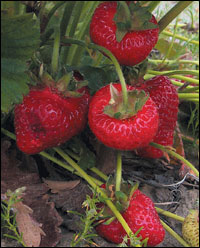Once a year, in late spring, a kind of miracle happens, often announced only by a humble notice felt-tipped on a scrap of cardboard reading “local strawberries.” Don’t assume that means no more than, say, “local zucchini” or “local carrots” might. It also means “delicate, easily bruised, ruined by refrigeration, compromised by damp, to be eaten immediately while breathing a silent prayer to the god of spring and the achingly transitory beauty of life.”
These berries have almost nothing but general appearance in common with the bright-red, firm-fleshed, ivory-freckled cones one sees on produce counters throughout the rest of the year. Those don’t just hail from California or Chile; they come from another species of plant entirely, one that can be goosed into producing fruit for six months instead of six weeks, and are bred to stand up to refrigeration, repeated handling, and long-haul transport without losing a whit of their flavor: a flavor very much like that of an English cucumber, though not as sweet.
Strawberries grow wild all over the temperate zones of both hemispheres, but the plump, luscious variety that calls out for clotted cream and crumbly shortcake is only a few hundred years old and the product of a chance cross of a Chilean beach strawberry (smuggled home by a French spy) and a wild North American woodland variety. For 100 years or more, strawberries were a feature of cottage gardens only, but around 1840, commerce in strawberries began. Since then, hundreds upon hundreds of varieties have come and gone, nothing more remaining of most but their names: Hovey, Sharpless, Gandy, Miners Prolific.
One reason strawberry cultivars are constantly changing is that their fruit is even more attractive to fungi, nematodes, and other pests than it is to us. The way strawberries grow, close to the ground huddled under their own leaves, renders them open to attack from all sides. Most strawberry plants lose their vigor after three seasons, but many have already succumbed by that time to disease. Growers are constantly searching for new disease-resistant varieties, while the diseases continually become more efficient in their attack.
Last week, a dozen growers and breeders assembled in a field near Puyallup to see what Washington State University’s strawberry program had to offer for 2003. Under the lowering eyes of condo complexes and mobile-home parks on all sides, they browsed through beds of plants bearing enigmatic four-digit numbers (selected as promising among 2001 and 2002’s experimental crops), then spread out across a vast field containing 8,600 plants of the 2003 vintage. Dr. Pat Moore, WSU’s strawberry guy, figures that once he’s finished rating the new batch on color, flavor, firmness, productivity, etc., maybe 15 will make the cut and earn four-digit serial numbers of their own. From first random cross to commercial production can take 10 years or more.
For growers, the evolutionary arms race between breeders and predators is crucial, but consumers want their berries now, and for now, in these parts anyway, the berry to beat, the berry bar none, is the one they call Hood. Brought to birth by George Waldo of Oregon State University, it went on the market in 1965, and while other varieties have come and gone, Hood is the choice of berry professionals when it comes to flavor. (H䡧en-Dazs uses Hoods for its strawberry ice cream.)
In a late spring followed by a sultry heat wave, Hood berries are just now coming to market. Their season is shortnot more than four weeks. We can still look forward to later-season berries of good repute, to Rainiers and Puget Summers, but for fresh consumption, nothing beats Hoods. Ask for them by name; if enough of us do, produce departments may be nagged into providing the same varietal information for berries that they already offer for humbler produce like onions, potatoes, and oranges.
Of course, you don’t have to put your trust in a supermarket produce clerk; you can go to a farmers market and buy from the producer or follow a venerable Northwest tradition and go to the producer and pick your own. There’s no need to become an aficionado of jam making to make this practical, either. With a few dollars worth of dry ice and some Ziploc freezer bags, you can now freeze even delicate berries so hard so fast that, slowly defrosted in the fridge, they are hard to tell from fresh. Think about it: June strawberries in December. Now that’s a miracle.
For a comprehensive list of local strawberry producers and U-pick programs, pick up a free copy of the 2003 Puget Sound Fresh Farm Guide at any public library or go to www.pugetsoundfresh.org.








